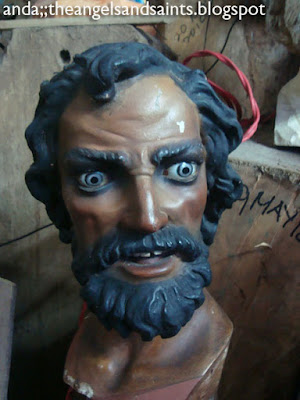HUDYO BELIEVE? A century-old head representing a blue-eyed "Hudyo", possibly, a temple officer.
“Hudyo!!”—this is a popular collective term for those wooden figures found on processional religious tableaus representing soldiers, sentry guards, cavalry men and centurions. Associated with tormenting Christ during his Passion, these “Hudyos”(Jews) —represented with stern expressions, beards, moustaches, sideburns and wide-open googly eyes are cited in several Gospel passages.
For example, Herod had a personal army that consisted not only of Jews but also of foreign mercenaries. Pilate and other Roman governors also kept Roman soldiers, with some recruited from Greece. Events involving soldiers include the following scenes that have been visually translated into religious tableaus familiar to most Filipinos.
Arrest of Jesus. John 18:3 mentions the presence of a contingent of Roman troops to support this arrest. Jesus Before the High Priest: When Jesus appeared before the high priest, only Jewish officers were present (Matt 26:58). They struck Jesus and beat him up after the verdict. Jesus Before Pilate: Pilate ordered Jesus to be beaten and mocked by his soldiers (Matt 27:27-30). Most were recruited from the Syrian Greeks, known for their hostility towards Jews.
Jesus before Herod Antipas: Pilate sent Jesus to Herod, hoping to avoid the problem of executing Jesus. Herod’s soldiers, who were probably Jewish, mocked Jesus and gave him a royal robe (Luke 23:6-12).
The Fall of Christ: The most popular depiction of soldiers, spearmen and footmen are on tableaus depicting the three falls of Christ (primera, segunda, tercera caida). The fallen Christ is shown surrounded by hostile looking soldiers armed with spears, lances and standards.
The Crucifixion: Roman soldiers presided over the crucifixion of Jesus. In the Calvary scene, they are attendant figures positioned at each side of Jesus, holding lanes and spears.
Figures of “Hudyos” are sometimes included in pasos like Simon the Cyrene Helping Jesus (guards behind the cross), Scourging at the Pillar (guards doing the actual whipping), Crowning of Thorns, Paciencia (the seated Jesus flanked by guards), Guarding of the Tomb, Piercing of Jesus (by Longinus).
Because of the way they are presented on Lenten tableaus, the mere sight of uniformed “Hudyos” with their devilish expressions and weapons, can instill fear and panic among children watching the Holy Week processions.
REFERENCE:http://www.thegoodbookblog.com/2011/mar/14/soldiers-in-the-gospels/













It is said that the faces of these "hudyos" are based from that of abusive Spaniards, so in a way, these were a silent propaganda against the colonizers back then.
ReplyDelete